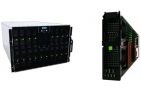French IT vendor and provider of Cloud-based infrastructure services Bull has launched a new series of “ultra-dense” petascale supercomputers. Powered by Intel Xeon E5 (codename “Sandy Bridge”) processors, the bullx B510 series of blade computers is twice as powerful than the company’s comparable previous-generation machines in terms of both processing power and memory speed, Bull said.
Multiple systems based on bullx B510 blades made it to this year’s Top500 list of the world’s most powerful supercomputers. At the top of the latest list, which was released last week, is Fujitsu-made K computer at the RIKEN Advanced Institute for Computational Science in Japan.
The K computer is powered by Fujitsu’s own SPARC64 microprocessors. Bull is already building supercomputers based on the new blades for a number of high-profile customers in its home country, including the French National High-Performance Computing Organization (GENCI) and the French Alternative Energies and Atomic Energy Commission (CEA).
Bull is building CEA’s supercomputer, called Helios, in Rokkasho, Japan. It is powered by 4,410 bullx B510 nodes. The commission will make it available for scientists around the world to use in researching controlled nuclear fusion.
François Robin, director of the International Fusion Research Center’s (IFERC) Computational Simulation Center project, said Bull’s system was chosen for density and power. “As a result, Helios will enable the international IFERC community to make significant progress on research into plasmas and controlled fusion,” he said.
The new blades can be used to provide 37 teraflops in a single rack, where twin-socket processing nodes are paired within the blades. Bull attributes the horsepower to Xeon E5 processors, extremely high memory capacity (up to 256GB per blade) and totally non-blocking InfiniBand QDR or FDR connectivity.
The blades will be generally available starting in the first quarter of 2012, as soon as Intel releases Xeon E5 chips.

